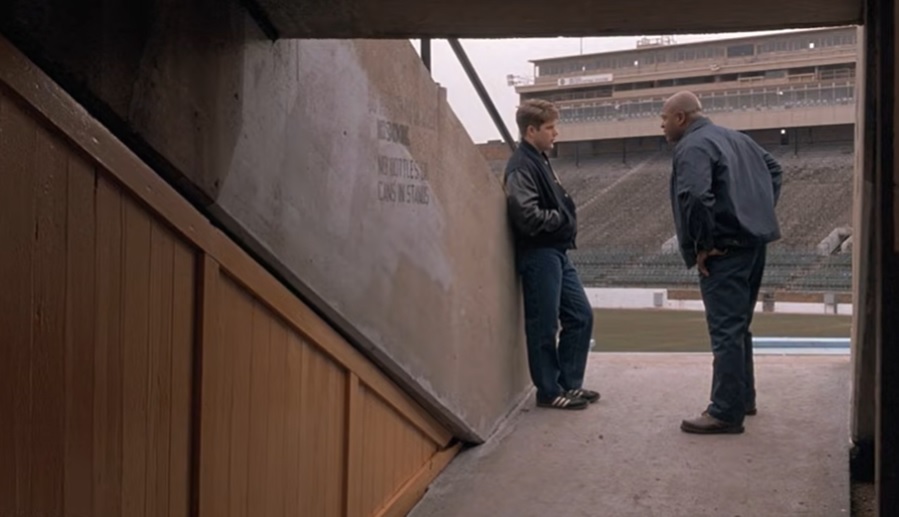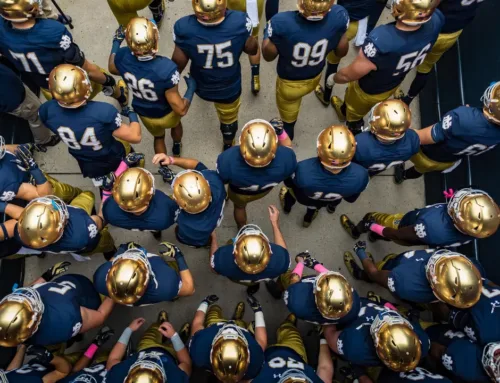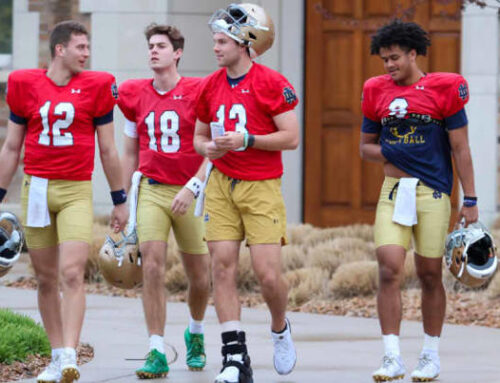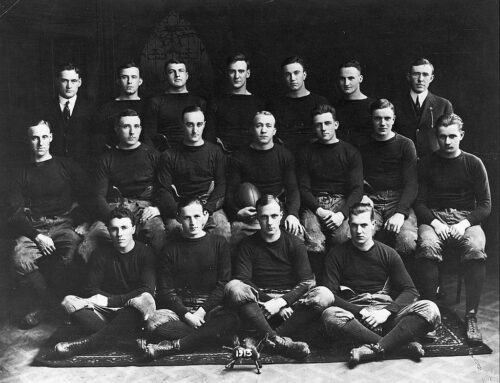Notre Dame may be switching back to a natural grass football field.
There, did I write a sufficient catchy introductory sentence? Allow me to immediately backtrack and state that I don’t believe Notre Dame is going to switch to a grass field, at least not any time soon. However, after 8 seasons using field turf, and a pretty strong consensus that the days of natural grass may never come back, it’s possible the door is opening to the sights and smells of the real stuff.
Player Safety
The Name, Image, and Likeness Era has transformed college football very quickly and its almost reckless abandon (at least in some areas, at some colleges) has shifted the balance of power closer to the players in a way that is causing many to reassess the entire landscape.
Fans, in particular, who were more apt to side with the forces surrounding the school leadership and its traditions are now finding themselves swinging strongly in the opposite direction towards player empowerment.
With this in mind, it’s likely we will see more college football players begin to raise their voices over the type of playing surfaces at their schools.
Is natural grass safer than the variety of field turf options across the country? We’ll get to that answer in a second but first it’s more important to realize players in the NFL prefer playing on natural grass.
There have been surveys done in the past that overwhelmingly favor natural grass and in September 2020 JC Tretter, the president of the NFL Players Union, called for all NFL teams to switch to real grass fields–both in their stadiums and practice facilities.
Whether turf is in fact more dangerous hasn’t been studied super extensively, particularly for football, but the research would suggest more of a health risk compared to natural grass. Here’s the blurb from Tretter’s article from a couple years ago:
Based on NFL injury data collected from 2012 to 2018, not only was the contact injury rate for lower extremities higher during practices and games held on artificial turf, NFL players consistently experienced a much higher rate of non-contact lower extremity injuries on turf compared to natural surfaces. Specifically, players have a 28% higher rate of non-contact lower extremity injuries when playing on artificial turf. Of those non-contact injuries, players have a 32% higher rate of non-contact knee injuries on turf and a staggering 69% higher rate of non-contact foot/ankle injuries on turf compared to grass.
We don’t have an army of scientists giving us conclusive evidence that synthetic turf is terrible–and while the evidence suggests it’s slightly more harmful–the reality is that the professional players prefer natural grass and this could eventually trickle down to the college game at placed like Notre Dame.
Notre Dame’s Problem
In regards to Notre Dame, there’s been a contingent of fans who prefer natural grass. While the safety concerns have been lurking in the background and will now take more of a center stage, I believe many preferred grass on aesthetic grounds, both for the look and smell, but also the ethos of being traditional and old-school or insert whatever word you’d like to use.
Do I need to rehash the blue-collar fetishizing argument?

Are they talking about Rudy’s football career or mower lengths for the grass?
We all have our preferences I suppose but the missing piece to this discussion is that the field at Notre Dame Stadium used to have poor grass. The NFL players are nearly effusive in their praise of the grass used by the Cardinals, less so for teams like the Bears and Commanders. Notre Dame’s old natural turf was more in line with the latter NFL teams.
For some in the pro-grass crowd this has largely been glossed over, ignored, or sometimes denied.
There doesn’t seem to be one major reason for these struggles, but a combination of things. Many have pointed to the swamp land the school was built on decades ago. Or, the poor soil in and around the stadium. Others, point to the specific weather conditions in South Bend coming from the winds off Lake Michigan.
There are others who have maintained that the grass field was mismanaged through the years with drainage issues not fully dealt with properly over the course of multiple renovations.
Whatever the reason, it’s not a situation where Notre Dame can automatically have a pristine natural grass field at the snap of a finger. It’s not a case of a Cardinals’ grass field field versus field turf and making that comparison is not a reality.
A natural grass solution is far from that simple.
Into the Future
If Notre Dame is going to switch back to natural grass it’s going to cost a lot of money. Or should I say, it should cost an enormous amount of money. If it’s something they are going to do it’ll have to be done with extreme effort, including an extensive soil study and drainage project that potentially means the Irish wouldn’t be able to use the stadium for a season.
Actually, a year of barnstorming and playing home games at Soldier Field–something Knute Rockne’s 1929 team did after Cartier Field was razed and Notre Dame Stadium built–would be kind of cool. It was a National Championship season after all, so maybe good vibes?
There’s a cost-benefit analysis to be made but even if they were to move forward with a natural solution the results could still be problematic. For example, players do tend to like the consistency of field turf, especially in wet conditions, and the ability to plant and cut without many problems. Natural grass is usually inferior in this regard and many poor natural grass fields (see, Stanford) are especially poor in this area.

Senior Day 1991 with the field looking not great in the years before HD cameras.
Let’s not forget that many fans at places like Purdue, Michigan State, and Northwestern complain about their grass fields, too. Most of these northern schools are forced to keep their grass longer than schools in warmer climates–which maybe people find aesthetically pleasing–but it slows down fast football teams and contributes to the plodding Big Ten-type of play that isn’t winning a lot of trophies these days.
Also, Notre Dame has 3 field turf practice fields (plus an additional outdoor natural grass field) which includes the newly constructed indoor Irish Athletic Center. The players are spending a vast majority of their time on these practice fields and the cost in order to convert the IAC into a workable grass field would be astronomical.
Of course, you can keep many of the non-football activities in the stadium with natural grass but yet again there’s another financial cost to doing so.

Free Flick on the Field gets more complicated with natural grass.
There are people who want this to be a football-only decision but the university is only a few years past a half billion dollar renovation project whose primary purpose was to ensure Notre Dame Stadium is in fact not just a football-only facility.
There’s really no way to put natural grass inside the new indoor practice field without the space and time/manpower to wheel a mobile system in and out during the spring and fall. You could spend less time in a $50 million facility I suppose, but that doesn’t seem realistic.
Therefore, only focusing on changing the actual stadium to natural grass feels much more like a cosmetic and aesthetic choice, which if we’re being totally honest, has always been the driving force behind the choice and not player safety. At Notre Dame specifically, perhaps the players will eventually speak up and demand a $50 million (how much would it cost!?) field surface change to natural grass inside the stadium but I get the feeling nearly all of them feel the dangers of playing on field turf are not great enough to make such a request.
The best and smartest way moving forward may be to seek out better and safer field turf solutions. Perhaps that is something Notre Dame as a school should look into researching to try and get something that works specifically for themselves.





There’s probably a very good reason they aren’t used much, if at all, in the U.S., but grow lights seem to be fairly prevalent on EPL grass when the pitch is not in use. Granted, British winters aren’t nearly as brutal as those in GB, Chicago & Buffalo, but would grow lights at least keep the grass from clumping up by mid October like it does in Soldier Field? I’d have to think the combination of heating underneath, proper watering and grow lights could at least keep natural grass presentable until the week before Thanksgiving for a Notre Dame season.
Heating and grow lights would be necessary. Not adding those features and making the switch is negligent, IMO.
Tottenham’s stadium is a modern marvel in this regard. Move the entire grass pitch out on rails with the field turf underneath. They use LED grow lights for the grass while it’s in the parking garage along with autonomous mowers. When the grass is out in the stadium, they use the rail system to move the grow lights around so no wheels are touching the surface.
Generally amazed at how “good” the grass in the EPL looks even in the dead of winter, but watching the Liverpool-Norwich game on Saturday, the Anfield pitch looked terrible. No excuse for a club of that prestige to have such bad looking grass ::cough:: Chicago Bears / Chicago Parks Department ::cough::
Turf is objectively the worst and I am all for teams moving away from it (yes i am salty my own career and the panthers season were both practically ended by it) shit is like trying to play football in the french countryside in 1918
ND reluctantly went to turf. I think they’ll be even more reluctant to go back to grass.
I would prefer a grass surface, but as you said really for only aesthetics. All the infrastrucutre and money that would be required a la an epl style grow system to maintain the grass for what would basically be the three home games from late October and November when it finally isn’t able to recover naturally would just be silly. But man tho, the fieldturf just looks so awful on the broadcasts. It has like a plastic looking sheen in the sunlight. You could even see it in the Freeman’s family pics on the stadium turf. My vote would be for a better fieldturf.
Is hybrid field turf/grass a thing yet?
Well, my northern Michigan high school tried that 20 years ago, put a patch of fieldturf in the six yard box of our soccer field, cause you know northern michigan is a sand pit. Created a weird bounce pattern going from grass to turf for the goalies, it was beyond ridiculous.
I was thinking more along the lines of a mixture of the two, rather than a turf toupee.
Green bay has something like that.
Hybrid turf, underground heaters keep Lambeau tundra just right | Fox News
Natural grass reinforced with synthetic fibers is pretty common nowadays. Basically sewing fiber into the soil to add extra strength.
I know the Packers recently switched to the SIS system a few years ago that works pretty well. The layers from the top look like this:
Grass
Soil
Fibers through soil
Sand
Pea gravel
Drain tile
Heating system
That Freeman photo looks like it’s taken at dawn or dusk and maybe has a filter applied to it, too. It could explain some of the weirdness to the field. But, the turf has started to fade no doubt about it.
2014 Rice:
2021 Toledo:
The ’21 game was a little sunnier at kickoff but you can clearly see the green color has started to fade. If I remember correctly, 8-10 years is usually the life of a field turf field so it may be replaced soon.
This is probably a dumb reason, but I prefer grass only cause I like to see the uniforms get dirty. Like the OT thriller against Clemson looks odd on highlights where you can’t tell if it’s the first quarter or the end of the second OT.
Not sure if anyone caught Gene Smith’s comments about northern schools hosting potential playoff games indoors, out of state. I personally hated that comment and I personally think on-campus playoff games is one of the biggest positives for expanded playoffs.
Like he was saying outdoor northern teams shouldn’t host?
I should correct myself a bit. He was speaking in regards to Ohio State and what he would recommend.
Smith said he thinks the College Football Playoff will expand. “I would be surprised if we don’t go to 12 at some point.” Said Ohio State could potentially host games at Detroit’s Ford Field, Indianapolis’ Lucas Oil Stadium and Minneapolis’ U.S. Bank Stadium because inclement weather in the north in December could make it hard to host at Ohio Stadium.
Smith said he would actually recommend it be hosted indoor to have a “clean field” for the players. “I would want C.J. (Stroud) to have good weather … While it would be difficult to take it away from the ‘Shoe, it’s the right thing to do for the players. – per SI/fansided
Well that stinks.
I personally wouldn’t love a bunch of playoff games happening in snow/windy weather all the time so I get the concern. But, those type of events would be pretty rare, I think.
Does this mean Smith can never be AD at Notre Dame 🙁
I agree with you, don’t want every playoff game to be a snow globe ala the Bills/Pats game this year. I also think it would be rare especially when you look at the NFL over the years.
Saw a good point regarding this move, don’t think the local business owners/politicians would be very excited about all of the revenue moving to a different market so I imagine there would be a fight over this.
I know it’s all politics, but I was hopeful the comments from the preeminent northern program would challenge the southern schools to step outside of their bubble and have to play in the cold. Probably reading too much into it, but feel like it’s an uphill propaganda push by schools like ND, Mich, MSU, & Penn State when the best program doesn’t want it to be outside just as much as the southern schools.
Good article. Very thorough.
It’s Notre Dame. I’m sure they can assemble a team of bright turf management guys/girls.
…..So I was thinking how it is a bit ironic how the move to turf was supposed to be the ideal move for a sophisticated, modern day program that appealed to recruits (as if recruits cared that much about ‘looking modern’ particularly the bright, well rounded, big picture kids that seek ND). But now it turns out that players actually don’t like it that much, it is not necessarily the optimal playing medium, and that it goes beyond pure aesthetics. Amiright tho?
I didn’t listen but one of our writers mentioned in the latest In the Garage podcast the ND players didn’t really seem to care about the turf. So I don’t think there’s a groundswell of support for the real stuff going on behind the scenes.
Yeah, I heard that podcast and they were far from Team Grass. From hearing them, I got the impression that for the majority of the kids, turf is seen as the standard and the pro-level surface that they want to play on and expect major D1 programs to have for not only playing fields but for their practice facilities as well. I don’t think they care about the aesthetics so much as they want the best surface for performance reasons to showcase their speed/skills. That’s a small sample of a few of them, admittedly, but I’d bet it’s a popular opinion.
Come on, it’s just one grass field, how much could it cost, ten dollars?
This is an excellent article on a timely topic.
Don’t I remember when this was all being debated fiercely just before we went to turf, that there was a very intense and technical discussion about the peculiar deep drainage underlying conditions of the field inside the Stadium? Some complexities with soil composition, etc. that made it seem extremely unlikely we could get a good grass field that would hold up in late autumn?
The thing I will never forget is attending the Notre Dame/Oklahoma game in 2013, at ND Stadium, and watching ND staff come out on the field during commercial breaks, stomping down divits in the field. And this was on a warm day, early in the season.
I’m so glad we don’t have THAT surface any more.